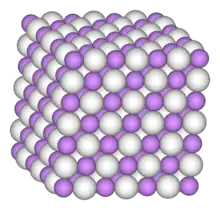Hydrogen astatide
Hydrogen astatide, also known as astatine hydride, astatane, astidohydrogen or hydroastatic acid, is a chemical compound with the chemical formula HAt, consisting of an astatine atom covalently bonded to a hydrogen atom.[2] It thus is a hydrogen halide.
 | |||
| |||
| Names | |||
|---|---|---|---|
| IUPAC name
Astatane[1] | |||
| Identifiers | |||
3D model (JSmol) |
|||
| ChEBI | |||
| ChemSpider | |||
| 532398 | |||
PubChem CID |
|||
CompTox Dashboard (EPA) |
|||
| |||
| |||
| Properties | |||
| HAt | |||
| Conjugate acid | Astatonium | ||
| Conjugate base | Astatide | ||
| Related compounds | |||
Other anions |
Hydrogen bromide | ||
Except where otherwise noted, data are given for materials in their standard state (at 25 °C [77 °F], 100 kPa). | |||
| Infobox references | |||
This chemical compound can dissolve in water to form hydroastatic acid, which exhibits properties very similar to the other five binary acids, and is in fact the strongest among them. However, it is limited in use due to its ready decomposition into elemental hydrogen and astatine,[3] as well as the short half-life of the various isotopes of astatine. Because the atoms have a nearly equal electronegativity, and as the At+ ion has been observed,[4] dissociation could easily result in the hydrogen carrying the negative charge. Thus, a hydrogen astatide sample can undergo the following reaction:
- 2 HAt → H+ + At− + H− + At+ → H2 + At2
This results in elemental hydrogen gas and astatine precipitate. Further, a trend for hydrogen halides, or HX, is that enthalpy of formation becomes less negative, i.e., decreases in magnitude but increases in absolute terms, as the halide becomes larger. Whereas hydroiodic acid solutions are stable, the hydronium-astatide solution is clearly less stable than the water-hydrogen-astatine system. Finally, radiolysis from astatine nuclei could sever the H-At bonds.
Additionally, astatine has no stable isotopes. The most stable is astatine-210, which has a half-life of approximately 8.1 hours, making its chemical compounds especially difficult to work with,[5] as the astatine will quickly decay into other elements.
References
- Henri A. Favre; Warren H. Powell, eds. (2014). Nomenclature of Organic Chemistry: IUPAC Recommendations and Preferred Names 2013. Cambridge: The Royal Society of Chemistry. p. 131.
- PubChem, "astatane - Compound Summary", accessed July 3, 2009.
- Fairbrother, Peter, "Re: Is hydroastatic acid possible?", accessed July 3, 2009.
- Advances in Inorganic Chemistry, Volume 6 by Emeleus, p.219, Academic Press, 1964 ISBN 0-12-023606-0
- Gagnon, Steve, "It's Elemental", accessed July 3, 2009.








